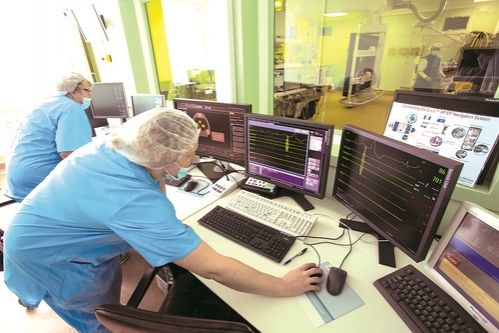Whoever would have thought that medicine to treat myocardium diseases exists in the spinal cord? The Cardiology Republican Scientific and Practical Centre can now implant stem cells into the heart, with six successful surgeries accomplished.

Cardiology Centre boasts achievements at the highest level
Short wind, chest pain, dizziness and weakness are the result of stress on the heart, and disease can begin at any age, among both sexes. Complications tend to arise and, in many cases, transplantation is the only answer. However, Belarusian cardiac surgeons have mastered a new technique, improving quality of life for years.
Visiting the Cardiology Centre, Yelena Kurlyanskaya, who heads the laboratory of chronic cardiac insufficiency, shows me a heart on the monitor, and where stem cells have been injected, aiming to ‘awaken’ sleeping cells. She explains, “New cells penetrate the heart and transfer impulses to other cells. After some time, the contractile force of the myocardium improves.”
“Can it remove all symptoms at once?” I ask, to hear, “Much depends on the individual but we had a patient who responded very quickly, within four weeks. It usually takes three to six months, but most see a real difference in their ability to engage in physical activity, such as walking without being short of breath.”
The surgery is as ‘quick’ as that of removing the adenoids, with patients placed under sedation, and then returning home the next day, able to work once more, without rehabilitation. Ms. Kurlyanskaya notes, “All patients are able to resume mobility after surgery, regardless of suffering from symptoms of cardiac insufficiency. If we didn’t act, they’d need a heart transplant within 1-3 years. We don’t yet know how long stem cell treatment will continue to be effective, but we hope for enduring results. Some may avoid needing heart transplantation at all, while some may be able to wait longer before becoming urgent. We’re targeting those we feel 90 percent confident of helping.”

During examination, experts define zones for injecting stem cells, and 70 millilitres of marrow is removed, in a procedure which is rather painful. For the next month, 60 million cells are cultivated (at the Republican Scientific and Practical Centre of Children’s Oncology and Haematology). On the day of surgery, they are brought to the Cardiology Centre in a special syringe and are injected via catheter through a femoral artery, into the inactive sites of the heart.
Donor cells are not yet being used, as removing them from the marrow is painful. Few might be willing to endure this for the sake of a stranger.
Speaking of the age limit, Ms. Kurlyanskaya notes, “The treatment is viable until the age of about 53-55 years; after this, stem cell growth is less effective. The technology was introduced in Israel and is now being used in Austria, Canada, the USA and Germany, with Belarus having joined through a major international research project. If we enjoy a possibility to implant stem cells to more patients, we’ll expand grounds for this. The state allocates about $15,000 per patient, which is far cheaper than we’d spend on transplantation.”
By Olga Kosyakova











